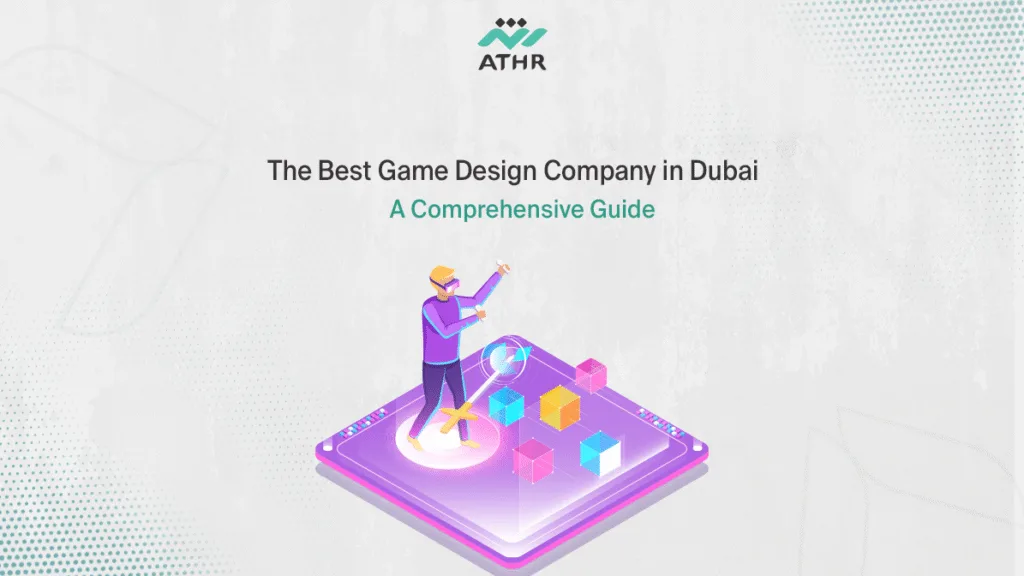Today, most customers spend their time on smartphones, seeking faster and easier ways to access services and products. This is where designing mobile apps for Android and iOS becomes a crucial step for any company aiming to boost sales and strengthen customer relationships.
A successful app isn’t just about a sleek look; it relies on well-thought-out strategies that ensure ease of use, security, and fast performance. We’ll share the key strategies that experts use to build professional apps that can powerfully support your business growth.
🏆 With Athr… your idea deserves to become a market-leading app!
جدول المحتوي
- Why Is Mobile App Design for Android and iOS Important for Business Success?
- Steps to Design a Professional App for Android and iPhone
- Best Strategies for Successful Mobile App Design
- How to Improve User Experience in Smartphone Apps
- Modern Mobile App Development Tools You Should Know About
- Tips from Experts in Mobile App Design for Android and iOS
- What is the difference between developing Android and iPhone apps?
- How can I ensure my app is competitive in the market after its launch?
- What are the best strategies for successful mobile app design?
- Why is mobile app design considered an important investment for businesses?
- How much does it cost to design mobile apps for Android and iOS?
- What are the essential steps to designing a professional mobile app?
- How do I choose the best mobile app development company for Android and iOS?
Why Is Mobile App Design for Android and iOS Important for Business Success?
Over 70% of global digital interaction happens via smartphones. This means customers spend most of their time inside apps, not just on websites.
- Apps give companies a direct communication channel with customers.
- They provide a personalized user experience tailored to meet market needs.
- They support growth strategies by collecting data and analyzing customer behavior.
Therefore, designing a professional Android and iPhone app is no longer an optional side project; it’s a strategic investment in the future of your business.
How Do Apps Enhance Brand Identity?
Designing mobile apps for Android and iOS is more than just coding; it’s a powerful marketing tool that helps you:
- Enhance Visual Identity: Through colors, logos, and interactive experiences.
- Build Trust: The smoother and more secure the app, the higher the brand’s credibility.
- Increase Loyalty: Through personalized notifications, loyalty programs, and a unique user experience.
Why Are Apps an Effective Way to Increase Sales?
Apps are not just a display tool; they are an integrated sales platform. Thanks to smart mobile app design strategies, companies can:
- Simplify the purchase process with fewer steps than a traditional website.
- Send exclusive offers via push notifications.
- Analyze customer behavior to offer personalized products that increase the likelihood of purchase.
🔑From concept to launch… learn the secrets of successful app design with Athr .
Steps to Design a Professional App for Android and iPhone
The mobile app design process goes through several key stages that help transform an idea into a functional reality, starting with defining goals, moving to a clear development plan, and ending with testing and improvement.
Define App Goals and Target Audience
The first step to a successful app is answering the question: “Why am I designing this app?”
- Is the goal to increase sales?
- Or to improve the customer experience?
- Or to build a strong brand identity?
After defining the goals, you must study the target audience:
- What is the most frequent age group using the app?
- What daily problems do they face that the app can solve?
Apps that focus on solving a real user problem achieve a 40% higher download rate compared to general-purpose apps.
Create a Clear Design and Development Plan
One of the best strategies for successful mobile app design is having a clear plan that includes:
- Creating a wireframe: To visualize the basic interface.
- Choosing tools and technologies: Such as selecting modern mobile app development tools (Flutter, Swift, Kotlin).
- Defining budget and timeline: To avoid financial surprises and launch delays.
Having a precise plan helps reduce errors and ensures the project is executed according to the set timelines.
Test the User Interface and User Experience
The success of any app largely depends on the user experience (UX) and user interface (UI).
- Conduct A/B testing to see which design achieves the best engagement.
- Ask a small group of users to test the app and provide feedback.
- Focus on ease of use and quick navigation between pages.
📌 79% of users abandon an app if its interface is complex or doesn’t meet their expectations. Therefore, investing in testing before the official launch is an essential step to ensuring success.
🔒Make your project more secure and professional – contact us to develop your app from scratch!
Best Strategies for Successful Mobile App Design

When you start designing mobile apps for Android and iOS, you must keep in mind that an app’s success depends on three main pillars: user experience, user interface, and technical compatibility. When these elements come together, they significantly increase the app’s chances of success and boost user trust.
Simplify the User Experience (UX) to Increase Engagement
The user experience is the heart of any successful app. The simpler and smoother the user’s journey within the app, the greater the chances of them engaging with your services.
- Make navigation between pages clear and easy.
- Reduce the number of steps to find information or complete a purchase.
- Add smart features like quick search or autocomplete.
Design an Attractive and User-Friendly Interface (UI)
The interface (UI) is the first impression a user gets of your app. A simple, consistent design based on your brand’s visual identity can make a huge difference.
- Use colors that align with your company’s identity.
- Focus on the clarity of icons and buttons.
- Ensure text is readable on various screen sizes.
🔑Apps like Spotify and Airbnb succeeded because they relied on simple and attractive interfaces that made the user experience both fun and easy.
Ensure App Compatibility with Various Devices and Versions
One of the best mobile app design strategies is to ensure the app is compatible with all devices (phones, tablets) and different operating system versions.
- Test the app on multiple Android and iPhone devices.
- Use tools like Firebase Test Lab to test performance.
- Continuously update the app to ensure it’s compatible with the latest OS versions.
Discover the secrets of mobile app programming that guarantee you’ll attract users and increase engagement – 📖 read the full guide now!
How to Improve User Experience in Smartphone Apps
User experience (UX) isn’t just about aesthetic design; it’s about the app’s speed, how well it meets user needs, and its effectiveness in achieving business goals. The better the experience, the more likely users are to keep the app and the higher your sales will be.
Performance Speed and Reducing Load Time
Nothing loses a user’s patience more than a slow app. Research indicates that 53% of users abandon an app if it takes more than 3 seconds to load (Google Research).
To improve performance:
- Compress images and files to reduce their size.
- Use clean, lightweight code.
- Rely on powerful servers to accommodate a large number of users.
Personalize Content Based on User Behavior
One of the secrets to the success of major apps like Netflix and Amazon is their ability to personalize content to suit each user’s interests.
- Analyze user behavior within the app.
- Provide personalized suggestions (e.g., similar products or additional services).
- Create a personalized experience that increases customer loyalty.
📊 Apps that rely on content personalization have a 60% higher retention rate compared to generic apps.
Use Smart Notifications to Increase Engagement
Push notifications are an effective tool for increasing engagement, but they must be used smartly.
- Send alerts about exclusive offers or discounts.
- Remind users of incomplete tasks (like an abandoned shopping cart).
- Provide useful content like tips or new updates.
⚠️ Excessive notifications can lead to app uninstalls, so notifications must be smart, targeted, and linked to user behavior.
Turn your idea into a successful app for Android and iOS – 📞contact us today!
Modern Mobile App Development Tools You Should Know About

The programming market has evolved significantly in recent years, with the emergence of powerful tools that simplify the process of designing a professional app for Android and iPhone. These tools have helped startups and large enterprises build highly efficient apps with faster development times.
Popular App Development Platforms (like Flutter and React Native)
Hybrid platforms like Flutter (from Google) and React Native (from Facebook) have become the first choice for many companies due to what they offer:
- Faster development using a single codebase that works on both Android and iOS.
- A user experience close to native.
- Support from a huge community that provides solutions to any problem you encounter.
📊 42% of global developers prefer Flutter because of its flexibility and continuous support from Google.
Interactive Design Tools like Figma and Sketch
An app’s success is not complete without a strong user interface. This is where design tools come in:
- Figma: Ideal for collaborative work between design and development teams.
- Sketch: Powerful for designing prototypes for iOS interfaces.
- Adobe XD: An excellent option for visually creating user flows.
Performance and Security Testing Solutions for Apps
Even with a good design, an app can fail if it’s not adequately tested. Therefore, using performance and security testing tools is an essential step before launch.
- Firebase Test Lab: To test the app on hundreds of different devices and systems.
- Appium: To conduct comprehensive automated tests.
- OWASP Mobile Security Testing Guide: To ensure user data is protected from breaches.
Tips from Experts in Mobile App Design for Android and iOS
Experts in the field of app design confirm that an app’s success depends not only on the idea but on the quality of its execution and its ability to keep up with market expectations. Here are the most important tips you should consider:
Follow the Latest App Design Trends in 2025
The app market is constantly changing, and old designs no longer attract users. In 2025, the most prominent trends are:
- Minimalist Design: Clean and easy-to-use interfaces.
- AI Integration: To personalize content and analyze user behavior.
- Dark Mode: An essential option for eye comfort and improved user experience.
The Importance of Relying on Responsive and Easy-to-Navigate Design
With the diversity of Android and iOS devices, a responsive design that ensures an ideal display on all screens is essential.
- Make buttons clear and easy to tap.
- Design interfaces that support one-handed use.
- Reduce cluttered elements that hinder navigation.
Investing in Data Security and Protection Testing
In a time of increasing cyberattacks, security has become a top priority for any app. Users want to feel confident when sharing their data.
- Use strong encryption protocols like SSL/TLS.
- Conduct regular penetration testing.
- Adhere to international standards like GDPR to ensure data protection.
📈 The average cost of a data breach can reach $4.45 million. Therefore, investing in security from the start protects your business from huge losses.
The future of businesses is being built on smartphones today, and having a professional app on Android and iOS means you’re closer to your customers than ever before. By relying on the best App Design and development strategies, you can provide an exceptional experience that boosts customer trust and doubles your chances of success.
Don’t let your idea stay on paper. Turn it into a real app that achieves your goals.




